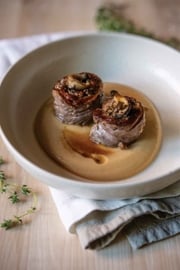Summer Strawberry Shortcake with Vanilla Cream and Strawberry Compote

A year-round classic, strawberry shortcake is elevated to high art with the intense flavours readily available from local growers.
2 1/2 cups (625 mL) all-purpose flour
1/2 cup (125 mL) light brown sugar
1 1/2 tsp (7 mL) baking powder
1 tsp (5 mL) baking soda
1/4 (1 mL) tsp salt
1/4 cup (60 mL) cold unsalted butter (small cubes)
3/4 cup (180 mL) buttermilk
1 Tbsp (15 mL) vanilla extract
Shortcakes
Preheat oven to 425 F (220 C) and lightly oil a baking sheet.
Whisk together all dry ingredients, breaking up any lumps by hand.
With a fork or two knives, work cubed butter into the flour mixture, cutting until the mixture resembles course crumbs.
Stir in buttermilk and vanilla until combined. (Do not overmix.)
Transfer dough to a floured work surface and press it into 3/4-in (1.9-cm) thickness. Using a floured 4-in (10-cm) cutter, cut out 6 biscuits. (Reserve any remaining dough by wrapping firmly and freezing for another day.)
Transfer shortcakes to the baking sheet and sprinkle with a coarse sugar. Bake biscuits for 10 to 12 minutes and allow to cool.
Vanilla Cream
4 cups (1 L) ricotta cheese
1 banana
2 Tbsp (30 mL) sugar
1 tsp (5 mL) fresh lemon juice
1 Tbsp (15 mL) vanilla extract
Place all ingredients in a blender and puree until smooth. Add a touch of milk or cream if you find the mixture too thick.
Strawberry Compote
8 cups (2 L) strawberries, halved
1/4 cup (60 mL) sugar
2 Tbsp (30 mL) Grand Marnier (optional)
Place all ingredients in a bowl and mix well. Allow to marinate for at least 30 minutes. This will draw the natural syrup out of the berries. Reserve the intensely flavoured strawberry syrup to work into the vanilla cream if desired.
To serve, simply plate a shortcake and top it with a generous dollop of the vanilla cream. Mound berries atop all.
Serves 6.
source: "Glowbal Thinking", alive #297, July 2007




